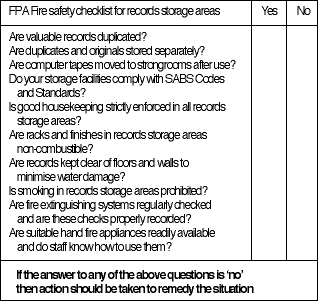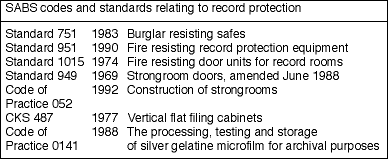
When a fire occurs, most people tend to consider its effects from the point of view of direct physical damage only. However, some time after a fire the inevitable consequential losses begin to be felt.

One of the most disastrous consequences of a fire is the loss of vital records, be they contracts, orders and sales documents, or plans, specification, blueprints, research data, computer discs, or photographic film records.
Since records media is almost always combustible, total effective fire protection may not be feasible and efforts should therefore be directed towards reducing the risk of fire in records storage areas. One of the most effective ways of limiting the disastrous effects of a fire in these areas is to prepare duplicates of essential records which should then be stored separately from the originals.

The choice of a storage area and specific storage methods needs careful consideration and a proper analysis of the probability of fire and its possible effects should first be made. The following criteria should be evaluated.
* Exposure - how susceptible is your records storage area to damage from fires starting on adjoining property or in your own building?
* What effect would fire, heat smoke, etc, have on your records and would fire extinguishing methods be an added hazard?
Methods of storage are varied but would probably include the following:
Bulk storage
Bulk storage in itself creates a fire hazard. The term bulk storage is used here to describe any sizeable collection of records not specifically contained in vaults, safes or fire resisting cabinets.
Bulk storage areas may contain file cabinets, shelving, cardboard boxes, blueprints, magnetic tape, film and other media. The location may range from a suitably adapted area within a general office complex to specially built record storage facilities.
Strongrooms
A strongroom is a completely fire resistive enclosure up to approximately 120 m3 in volume and used exclusively for storage with no work carried on inside it. It should be maintained and supervised so as to minimise the possibility of a fire originating within it. Provided the door is closed, the strongroom is designed to resist a severe fire of long duration on the outside. Strongroom standards generally prohibit openings in the walls, and services such as electrical cables from passing through them. Automatic sprinkler or similar fire control equipment can therefore not be installed in strongrooms. A method of protecting them is by using an automatic self-contained extinguishing system which is situated completely within the strongroom. Water extinguishers, and hose-reels should be sited as close to the door of the strongroom as possible.
Filing rooms
A filing room is a 2 hour fire resistive room of up to 1 100 m3 in volume. Lighting, heating, ventilation, etc are permitted inside file rooms, as are filing cabinets and furniture, provided they are non-combustible. Although it is not used as a working space other than for filing purposes, the file room is more susceptible to a fire than a strongroom. The installation of automatic fire detection and fire control systems should be considered in relation to the risk involved.
Types of records
Paper
Ordinary paper records have been found to survive most of the effects of fire, apart from direct flame exposure, reasonably well. Seldom are paper records totally lost during a fire as they have a high recovery rate, when exposed to damage by water, high humidity, smoke and moderately high temperatures. Non-paper records media tend to be more susceptible to these effects of fire.
Plastics
The combustibility of tapes and their containers should be considered, particularly when they are stored in bulk quantities. Polystyrene cases and reels present a severe fire hazard and burn fiercely, whereas acetate and polyester-based tapes burn less intensely. In any event, it is necessary to limit the height and extent of the storage of reels encased in plastics.
Photographic
Photographic records are essentially images coated with an emulsion. These images may be severely distorted or damaged by the effects of heat and humid conditions. Bulk storage of photographic records promotes no serious additional problem when compared to paper records, except that efforts should be concentrated on salvaging photographic records as soon as possible after a fire. Although water used in extinguishing the fire will not immediately damage the photographic emulsion, steam certainly will. In the presence of water vapour, temperatures as low as 90°C will produce serious distortion of film and adhesion of coils.
Magnetic
These records, as with photographic records, are extremely sensitive to emulsion damage. The effects of heat will cause a softening of the emulsion on a magnetic tape and could cause the layers of tape to stick together on the reel.
Fire extinguishing systems
The choice of one of a number of fire extinguishing systems depends on economic factors and the degree of protection required.
Automatic sprinklers
Automatic sprinklers have proven themselves effective in record storage areas. Water discharges only in the immediate vicinity of the fire, and salvage operations for the recovery of wetted items are fairly straightforward providing that they are immediately initiated. Accidental opening of a sprinkler head is rare.
Foam
High expansion foam is an effective fire control system for record storage areas though few systems have been installed to date. Water damage to any single item will be low but all items within the area involved will be affected to a minor degree. This type of protection will extinguish a fire very quickly.
Carbon dioxide
Automatic total flood carbon dioxide systems are probably the most common systems used for the protection of record areas. When these systems have been correctly installed they have extinguished fires quickly and do not add to the damage. There is a time delay before discharge as the protected area has to be cleared of people because the gas presents a life hazard in the high concentrations used in total flood systems.

© Technews Publishing (Pty) Ltd. | All Rights Reserved.